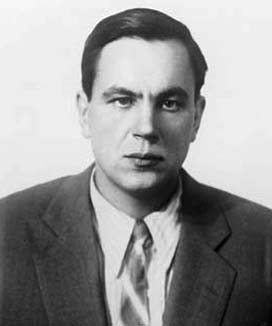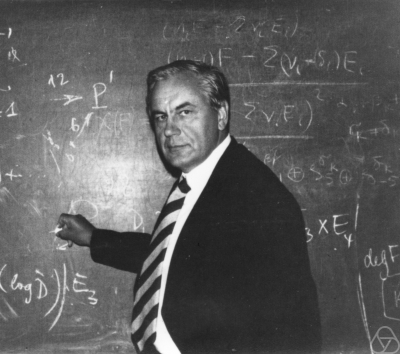<Back to Index>
- Mathematician Igor Rostislavovich Safarevich, 1923
- Painter Mikhail Fyodorovich Larionov, 1881
- Governor of Senegal Général Louis Léon César Faidherbe, 1818
PAGE SPONSOR


Igor Rostislavovich Shafarevich (Russian: Игорь Ростиславович Шафаревич, born June 3, 1923) is a Soviet and Russian mathematician, founder of a school of algebraic number theory and algebraic geometry in the USSR, and a political writer. He was also an important dissident figure under the Soviet regime, a public supporter of Andrei Sakharov's Human Rights Committee from 1970. He supported the criticisms of Aleksandr Solzhenitsyn of both Soviet communism and liberal proposals for the future of Russia.
Shafarevich made fundamental contributions to several parts of mathematics including algebraic number theory, algebraic geometry and arithmetic algebraic geometry. In algebraic number theory the Shafarevich - Weil theorem extends the commutative reciprocity map to the case of Galois groups which are extensions of abelian groups by finite groups. Shafarevich was the first to give a completely self - contained formula for the pairing which coincides with the wild Hilbert symbol on local fields, thus initiating an important branch of the study of explicit formulas in number theory. Another famous result is the realization of every finite solvable group as the Galois group over rationals. Another fundamental result is the Golod - Shafarevich theorem on towers of unramified extensions of number fields. Shafarevich and his school greatly contributed to the study of algebraic geometry of surfaces. He initiated a Moscow seminar on classification of algebraic surfaces that updated around 1960 the treatment of birational geometry, and was largely responsible for the early introduction of the scheme theory approach to algebraic geometry in the Soviet school. His investigation in arithmetic of elliptic curves led him independently of John Tate to the introduction of the most mysterious group related to elliptic curves over number fields, the Tate - Shafarevich group (usually called 'Sha', written 'Ш', his Cyrillic initial). He also formulated the Shafarevich conjecture which stated the finiteness of the set of Abelian varieties over a number field having fixed dimension and prescribed set of primes of bad reduction. This conjecture was proved by Gerd Faltings as a step in his proof of the Mordell conjecture.
Shafarevich was a student of Boris Delone, and his students included Yuri Manin, A.N. Parshin, I. Dolgachev, Evgeny Golod, A.I. Kostrikin, I.A. Kostrikin, S.Y. Arakelov, G.V. Belyi, A. Tyurin, V.A. Kolyvagin. In view of later accusations of anti-Semitism on his part, it can be noted that his research students included some identified as Jewish, and that later, during his most serious troubles in the 1970s with the Soviet authorities, he did major work in collaboration with Ilya Piatetski - Shapiro on K3 surfaces. He is a member of the Serbian Academy of Sciences and Arts in department of Mathematics, Physics and Earth Sciences.
On his 80th birthday, Russian President Vladimir Putin hailed his "fundamental research" in mathematics and his creation of "a large scientific school that is known both in Russia and abroad."
According to a statement he released in the mid 1970s, he had had troubles with the Soviet powers in the early 1950s, but was then for a time protected by Ivan Petrovsky, then Rector of the Moscow University. He belonged to the wing of the dissident movement that identified itself with the Orthodox Christian tradition in Russia; what is sometimes called the 'romantic nationalist' or Slavophile tendency. The position criticised the Communist Party as part of a broader condemnation of socialism; Shafarevich published a much noticed book Socialism (French edition around 1975) of destructive analysis, which was cited centrally by Solzhenitsyn in his 1978 address to Harvard University. From 1970 Shafarevich with Valery Chalidze, Grigori Podyapolski and Andrei Tverdokhlebov was one of Sakharov's human rights investigators. All this was a direct affront to the Soviet system, and Shafarevich was dismissed from Moscow University. Shafarevich continued to challenge the distortions of the academic system: as reported at the time by the algebraic geometer Miles Reid, he intervened in a doctoral defence of a communist party functionary, bringing up questions of plagiarism and inadequate work which were simply ignored (Shafarevich as an Academician in the Soviet Academy of Sciences could expect to be heard).
Shafarevich's 1970s book The Socialist Phenomenon was widely circulated in the West. After the Cold War, he started attacking Jews whom he called "small people who deny the historical achievements of Russia", saying his homeland must have "sound democratic statehood, based on the will of the people." His critics call him a radical, anti-Semitic, Orthodox nationalist.
He wrote from this period a number of essays, on topics such as the nationalities issues, Russophobia, and Shostakovich's treatment. These were very prominent, some being included in Solzhenitsyn's collection From Under the Boulders. Shafarevich's book The Socialist Phenomenon, published
in the US in 1980, argued that the leftist - nihilist utopian impulse is
a revival of gnostic religion, rooted in rebellion. In
his view, this is an anti-Christian urge that fights obsessively with
the normal state of the world, demanding material equality and the
eradication of individual and gender distinctions. Shafarevich
wrote that "the death of mankind is not only a conceivable result of
the triumph of socialism – it constitutes the goal of socialism." Shafarevich's views were influenced by Karl Wittfogel's theory of hydraulic society. The
mathematician argued that socialism has two archetypes: ancient
despotisms (such as Sumeria, Babylonia and Egypt) and millennial
sectarian movements of medieval and early modern Europe, along with a
Freudian death - instinct. Out of this combination, he said that this ideology works to co-opt the prestige of science and faith in progress. Shafarevich
covered in his work what he regarded as socialist tendencies and
socialist states that have occurred during the history of mankind. He
contrasts Campanella's (City of the Sun) and Thomas More's (Utopia) visions with the facts known of the Inca Empire and concludes there are striking similarities. Also, in Shafarevich's opinion, Marxist ideology has not even the climate of scientific inquiry. Marx's most important postulates are contradicted by the very reality: If
a socialist state comes into being only under the conditions created by
the development of capitalism, if, as Lenin wrote, "socialism
originates in capitalism, develops historically from capitalism, and
results from the action of a social force that is engendered by
capitalism," then whence did it come and as a result of what social
force did it develop in the Inca empire or the states of the ancient
Orient? History only reinforces the doubts engendered by the
contemporary situation: socialist states have arisen in China, North
Korea and Cuba -- that is, in the countries where the influence of
capitalism can in no way be considered a determining factor. During Perestroika, Shafarevich opposed both communism and Western democracy. On 21 December 1991 he took part in the first congress of the Russian All-People's Union headed by Sergei Baburin. In October 1992 he became member of the orgkomitet of the National Salvation Front that united extremist opposition movements. In 1993 he was a candidate for the State Duma with Mikhail Astafyev's Constitutional Democratic Party - Party of Popular Freedom, but failed to get elected. In 1994 he joined the All-Russian National Right Centre of Astafyev and N. Narotsnitskaya. Shafarevich was a member of the editorial board of the magazine Nash Sovremennik, and in 1991 – 1992 of the editorial board of Den of Alexander Prokhanov (which ceased in October 1993, and later reopened under the title Zavtra). Shafarevich's essays titled Russophobia and "Three thousand year old mystery" (Трехтысячелетняя загадка) resulted in accusations of antisemitism. He completed the Russophobia essay in 1982 and it was initially circulated in samizdat. In the USSR it was first published in 1989. In the Russophobia essay, referring to Augustin Cochnin's opinions,
he argued that great nations experience periods in their history, when
small reformist elitist groups ('small nations') that have values that
differ fundamentally from the values of the majority of the people,
gain upper hand in the society. Yitzhak M. Brudny writes that, in
Shafarevich's opinion, Jews represented such a 'small nation' in
Russia, and full of hatred against traditional Russian way of life,
first played an active role in the terrorist regime of Lenin and Stalin and then, during the Perestroika era were trying to implant into Russia the liberal values of the Western world. The ideas expressed in this essay have often been used in radical nationalist circles. He claimed that his sources were writings by Soviet emigrants of Jewish origin. He
complained that "Russophobes," who are cunning, hostile, Jewish
critics, "dream of transforming Russia into. .. a robot deprived of all
elements of human life." This publication led to the request by the US NAS to Shafarevich to resign his membership, because the NAS charter prohibited stripping an existing membership. In an open letter to the NAS, Shafarevich denied that Russophobia is antisemitic. Accusations of antisemitism have continued, involving Shafarevich's other publications. The criticisms are not all consistent, however, since critics disagree; where Semyon Reznik targets the Russophobia essay for its factual inaccuracies, and argues that Shafarevich depicts the murder of Tsar Nicholas II as an example of Jewish ritual murder,
and further notes that Shafarevich has assigned Jewish ethnicity to a
number of non-Jewish individuals involved in the execution and
perpetuates the false claims of graffiti in Yiddish at the murder site, Aron Katsenelinboigen,
on the other hand, stated that while there are multiple antisemitic
claims in Shafarevich's writings, he stops short of claiming blood libel. More recently Shafarevich expanded on his views in his book "Three thousand year old mystery". This work was published in Russian in 2002; an introductory section explains the relationship with the Russophobia essay, in the terms that the essay developed from an Appendix to an intended work of wider scope which he started writing in samizdat. It
contains further anti - Semitic allegations, as well as attempts at
justification of Stalin's repressions directed at Jews (such as
executions of the members of the Jewish Anti - Fascist Committee, several writers and poets, etc. in 1947 – 1953).
